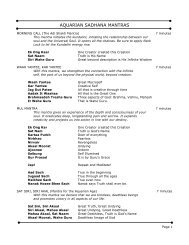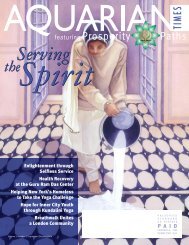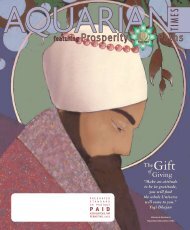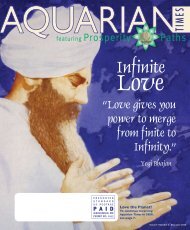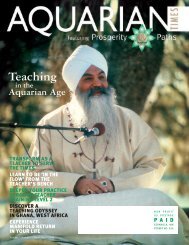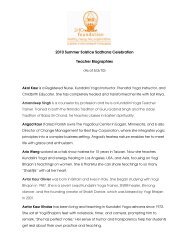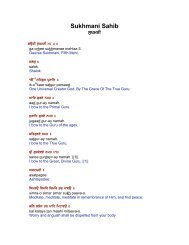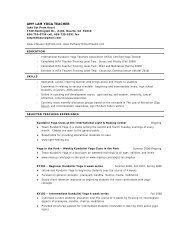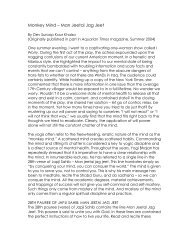July 2006 - 3HO
July 2006 - 3HO
July 2006 - 3HO
Create successful ePaper yourself
Turn your PDF publications into a flip-book with our unique Google optimized e-Paper software.
T<br />
he history of East and West provides a fascinating study in<br />
the contrasting difference in perception and understanding<br />
of the Universe. In the East, the origin and development<br />
of the inward spiritual practices of yoga and meditation<br />
date back to the most ancient of times in the Indus Valley<br />
civilization, which ended around 1,500 B.C.E. Archaeological finds from<br />
the ruins of this culture in Pakistan and Northern India have revealed<br />
artifacts strongly suggestive of the classic, cross-legged meditation/<br />
yoga posture. The subsequent history of the East is deeply imbued with<br />
a reverence for the value of the most profound internal experiences—<br />
the quest for mastery of the spiritual world. In contrast,<br />
Western culture has been more influenced by the birth<br />
and development of the scientific method, which has been<br />
used to systematically and precisely uncover the underlying<br />
physical nature and laws of the Universe, leading to the<br />
astounding technology that pervades life in the West: the<br />
quest for mastery of the physical world.<br />
Western Interest Begins<br />
The story of research into the practice of yoga and meditation<br />
is one that is characterized by this East/West contrast. One<br />
of the first interests in yoga came from the West after the<br />
European intrusion into India over the past three centuries.<br />
Dr. Bijlani (left) and Dr. Chinna (center), both yoga researchers and<br />
former chairmen of the Department of Physiology, with the author<br />
at the All India Institute of Medical Sciences.<br />
Early reports of the ability of yoga practitioners to alter their physiological<br />
state to the extent that they could survive prolonged underground burial,<br />
withstand pain, and stop their heartbeat suggested that somehow the<br />
laws of biology were being circumvented. This of course raised eyebrows<br />
among Western scientists of the time. In 1851, N.C. Paul, a regimental<br />
surgeon in Benares who studied yoga for 35 years, published his<br />
“Treatise on the Philosophy of Yoga” in which he analyzed, from the<br />
perspective of the Western science of the biology of gas exchange and<br />
metabolism, the cessation of breathing apparently involved in the yogic<br />
feat of underground burial and the relationship between frequency of<br />
breathing and yogic states of consciousness. Apparently, his book was<br />
ordered to be burned, an example of the bias against yoga research<br />
that persists in muted form even today. Ultimately, this kind of interest<br />
culminated in visits by Western physiologists to India in the middle of<br />
the 20 th century to study not only these yogic feats, but also the claims<br />
of profound psychological experiences.<br />
Perhaps the best example of this was the classic 1957 study entitled<br />
“Electro-physiological correlates of some Yogi exercises” by Basu Kumar<br />
Bagchi, a professor at the University of Michigan Medical Center (and<br />
close boyhood friend of Paramahansa Yogananda), and Marion A.<br />
Wenger, a psychologist at UCLA. These investigators spent five months<br />
traveling across India seeking out yoga masters and holy men. Using<br />
portable recording equipment they measured the physiological changes<br />
in these practitioners. The results of their study showed that yoga<br />
practitioners had extreme slowing of breath rate, the ability to slow the<br />
heart rate, and a deep relaxation of the autonomic nervous system.<br />
These findings have stood the test of time and have been echoed and<br />
confirmed by the results of many subsequent research efforts in yoga<br />
and meditation.<br />
Earlier Indian Research<br />
Research on yoga by Indian investigators in Indian laboratories generally<br />
preceded that done by Westerners. In 1924, Swami Kuvalyananda<br />
Research on yoga has included a<br />
broad range of study protocols which<br />
have examined a variety of changes<br />
in characteristics such as brain<br />
activity, mood, behavior, performance,<br />
hormone levels, blood chemistry,<br />
endurance, and flexibility.<br />
began research on specific yoga techniques and founded a research<br />
institute and a yoga research journal, both of which are still active<br />
today. More recently, over the past three decades, Indian researchers<br />
have contributed to a substantial proportion of the literature of yoga<br />
research. A landmark EEG study in 1961 by B.K. Anand, G.S. Chinna,<br />
and B. Singh, at the prestigious All India Institute of Medical Sciences<br />
in Delhi, revealed the ability of yogic meditators to control sensory<br />
input to the nervous system while in deep meditation. Currently, one<br />
of the most active Indian yoga research groups is the Vivekananda<br />
Yoga Research Foundation in Bangalore, which has a large and active<br />
research institute that has been granted university status by the Indian<br />
government and is offering graduate degrees in yoga. The appearance<br />
and practice of yoga as a therapeutic intervention began in India in<br />
the early in the 20 th century and continued through the 1960’s, when<br />
it was a popular therapy spawning the existence of “yogic hospitals”<br />
and precipitating the commissioning of a book on yoga therapy by the<br />
Indian government.<br />
The 1960’s<br />
The introduction of yoga and meditation to the West by Indian masters<br />
in the 1960’s generated a renewed interest among Western scientists,<br />
and most of the research in yoga and meditation has appeared since<br />
then. A landmark research project was the 1971 study by Herbert<br />
Benson and colleagues at Harvard Medical School that evaluated the<br />
physiological effects of Transcendental Meditation. Subsequently, Dr.<br />
Benson coined the term “relaxation response,” a distinct physiological<br />
change associated with reduction in arousal and metabolic rate elicited<br />
by many Eastern spiritual practices such as yoga and meditation.<br />
“Relaxation response” is essentially the opposite of the stress response.<br />
His meditation research has continued since then and he has worked<br />
with a variety of meditation styles, including the practices of Tibetan<br />
meditators and Zen monks, and has contributed substantially to<br />
our knowledge of the physiology of the relaxation response and<br />
to its clinical benefits. His basic research has shown the ability of<br />
meditators to reduce metabolic rate and stress activation, while<br />
his clinical studies have shown the effectiveness of the relaxation<br />
response in treating disorders such as headache, hypertension,<br />
stress, anxiety, infertility, and chronic pain. =<br />
<strong>July</strong>.AT.6.indd 25 6/6/06 2:32:24 PM<br />
2



